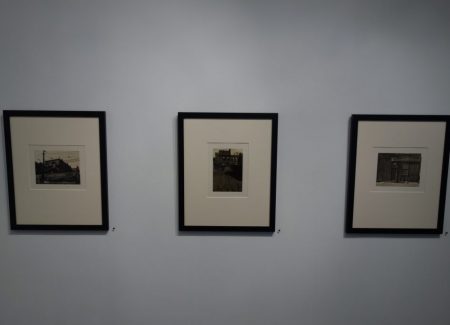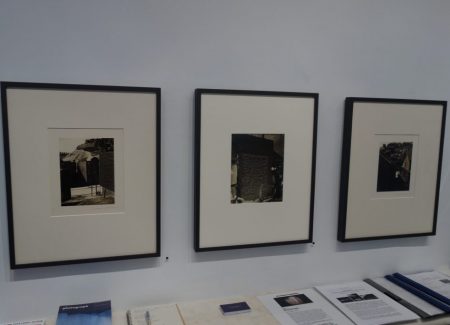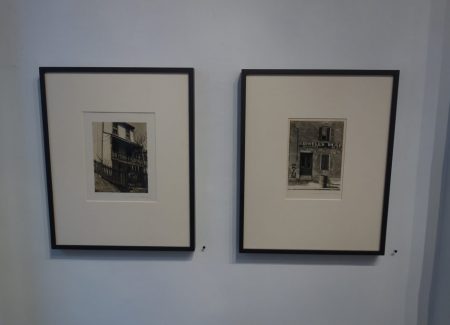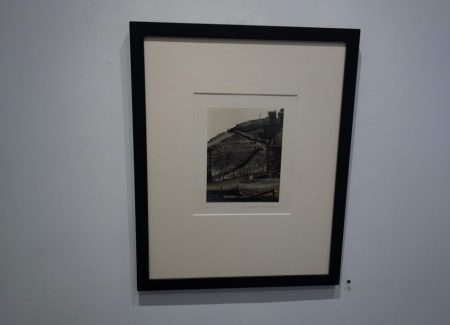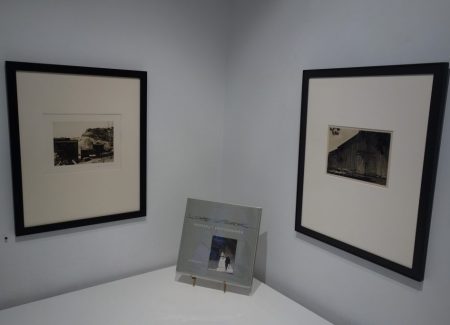JTF (just the facts): A total of 20 black and white photographs, framed in black and matted, and hung against white walls in the main gallery space and the office area. All of the works are vintage gelatin silver prints, made between 1930 and 1943. Physical sizes range from roughly 6×8 to 7×9 inches (or reverse) and no edition information was provided on the checklist. (Installation shots below.)
Comments/Context: We don’t usually think of art history as particularly dynamic or fluid, but the august history of photography is much more changeable than we might normally assume or expect. Of course, linchpin masters firmly anchor the chronology going back to the birth of the medium, but down a level of two, there is a constant reevaluation of the canon due to rediscovery of previously forgotten, overlooked, or marginalized photographers. It seems like hardly a year goes by these days without a largely unknown name from the past being unearthed from a storage locker or a dusty archive, forcing us to rethink once again how the historical pieces fit together.
When we unpack the monolithic history of photographic Modernism, what we find is that underneath the common aesthetic umbrella, regional variants popped up all over the world. When we look closely, the Modernism found in western Europe (particularly in Germany and at the Bauhaus), in eastern Europe and Russia, and on the west coast of the United States (particularly in California with the group f. 64) were all related, but still distinct flavors of artmaking, each influenced by their local geographies, political environments, and cultural realities.
This was also true of the Modernism that grew up in New York and on the east coast of the United States. This is the Modernism of Alfred Stieglitz and Edward Steichen, originally infused with the Precisionism of Charles Sheeler and later further adapted to the regional geography by Berenice Abbott, Walker Evans, and others in the 1930s and early 1940s.
Luke Swank fits snugly into the timeline of east coast Modernism (he too was actively working in the busy between-the-wars period), but his particular interest lay in his native Pennsylvania, specifically in the changing vernacular architecture of cities and towns. Swank’s photographs were broadly known by photographers on both coasts at the time and were shown in MoMA’s inaugural photography exhibition in 1940, but he died in 1944 and was largely forgotten until a 2005 exhibit and monograph organized by the Carnegie Museum of Art brought his images back into the light. This gallery show is the first show of Swank’s work in New York since 1934.
Swank’s compositions center on the built environment, from clusters of row houses and apartment buildings to cobblestone streets, wooden facades, and wrought iron fences. Rural farmhouses and barns are matched by urban storefronts and Pittsburgh streets, creating a tight sampler of rust belt Americana.
Given some commonalities of subject matter, Swank’s brand of Modernism seems to most closely match that of Evans, with echoes looking back to Sheeler’s views of similar barn and farmhouse architecture. Close in frames crop out the sky, leaving squared off frontal views filled with the details of textural wood siding, window and door frames, zig zag staircases, turned railings, and hand painted signage. In these pictures, Swank balances rigor and straight clarity with an active interest in surfaces, his warm toned prints often delivering layers of tactile richness. He was also clearly drawn to the insistent geometries of light and dark found in the buildings, where rooflines divide up facades and shadows play across walls and brickwork.
When Swank stepped back to orient the buildings in the surrounding landscape of hills, he used the curves of the land and the natural forms of mature trees to contrast with the blockiness of housing and commercial structures. The depth of the views allowed front and back to flatten into planes of light and dark, with telephone wires, roof lines, and walkways adding linear movement.
For those new to Swank’s work, the best of his photographs can clearly hold their own with images made by the various east coast Modernists, and his streamlined signature graphic gives his prints an extra dose of object quality. While he won’t challenge the more well-known names of Modernism for long term supremacy, his images help fill out the history of the period with enough consistency and craftsmanship to earn a durable secondary place in the narrative.
Collector’s POV: The prints in this show are priced between $3000 and $6000. Swank’s work has little secondary market history, so gallery retail likely remains the best option for those collectors interested in following up.
